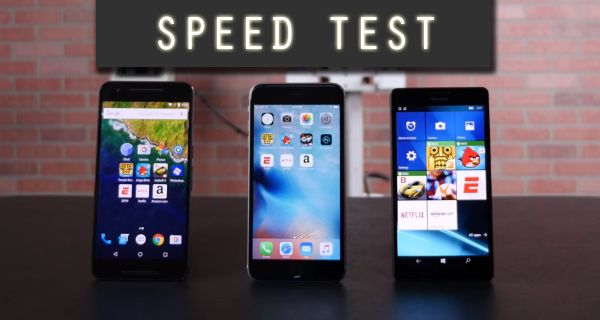
Posted on 12/25/2015 9:45:42 PM PST by Swordmaker
Purchases from big companies like Apple, Google, and Microsoft are always popular, but what happens when you pit three smartphones from those companies against one another in a straight up speed test? Carry on reading to find out.
As you might have guessed, this latest speed test video showcases three popular smartphones available on the market today. The nearly three minute long video takes the iPhone 6s Plus, the new Nexus 6P, and Microsoft’s Lumia 950 XL and thrusts them together over a series of challenges to see exactly how performant each is in comparison to the rest across a set of real-world usage scenarios that would impact every day users.

For the comparison, each device has its stopwatch running to time events before jumping into immediately launching and closing each of the native system apps that ships with each device. Obviously these apps differ based on the manufacturer and the underlying operating system, but each device does share some commonalities, such as camera, messaging, and photo apps. Google’s Nexus 6P immediately takes the lead by invoking and closing apps at lightning speed with gorgeous, fluid animations.
The video clearly demonstrates the fantastic marriage of hardware and software that Apple waxes lyrical about on a regular basis as it loads and powers through the starting sequences of Temple Run 2 with blazing speed. In fact Temple Run 2 has already been exit and Angry Birds put into gear on the phone even before the Nexus 6P has managed to move past the initial Temple Run loading screen. Microsoft’s supposed flagship, Lumia 950 XL, is pretty much out of the running at this point, although it does quickly catch up with the Nexus 6P on the next visual obstacle.

Such is the cruising power of Apple’s iPhone 6s Plus that it manages to finish the first obstacle course with a time of 58 seconds. A full 19 seconds ahead of the second place Nexus 6P and 25 seconds ahead of the Lumia 950 XL. That performance is better put into perspective when you consider that the iPhone took only one minute and twenty three seconds to complete the whole obstacle course, while Microsoft’s Lumia 950 XL had only managed to get past the first round in the same amount of time. The Nexus 6P meanwhile finished the entire course in two minutes and four seconds.
At the end of the video, you cannot help but marvel at the iPhone 6s Plus’ truly phenomenal performance considering its Dual-Core processor and 2GB RAM versus Octa-Core processor and 3GB RAM in Nexus 6P and Octa-Core processor and 3GB RAM in Lumia 950 XL.
(Source: PhoneBuff [YouTube])
You may also like to check out:

The latest Apple/Mac/iOS Pings can be found by searching Keyword "ApplePingList" on FreeRepublic's Search.
If you want on or off the Mac Ping List, Freepmail me
The advantage of multi-core processors is not in opening and closing individual apps but in multi-tasking many different apps at once. If you have your alarm clock operatiing at the same time you are talking on the phone while calculating a problem or browsing the Internet or watching a video, etc.
“The advantage of multi-core processors is not in opening and closing individual apps but in multi-tasking many different apps at once. If you have your alarm clock operatiing at the same time you are talking on the phone while calculating a problem or browsing the Internet or watching a video, etc.”
True, although the need for multitasking on a phone is generally lower than it is with a full-fledged computer. So Apple is probably taking a better approach for that type of device.
Another factor is that iOS uses pre-compiled, non garbage-collected programs, which provides some advantage.
Finally, the Nexus 6P made the mistake (along with many high-end Android phones) of going with too high of a resolution screen at 2560x1440 to win the “spec wars”. That is about double the pixel density that even the best human eye can actually perceive, and that means the graphics processor is doing four times the work on pixel fill for no reason. That probably accounts for the majority of the difference on the game benchmark. The one thing such a screen improves is VR where you mount the phone in a facemask like arrangement and see the screen through magnifying optics.
(BTW on multitasking - for a long time all computers were single core, and lots of them multitasked up to hundreds of users at a time. Those computers were far less powerful than today’s phones.)
Which had the best camera?
Disclaimer: Opinions posted on Free Republic are those of the individual posters and do not necessarily represent the opinion of Free Republic or its management. All materials posted herein are protected by copyright law and the exemption for fair use of copyrighted works.